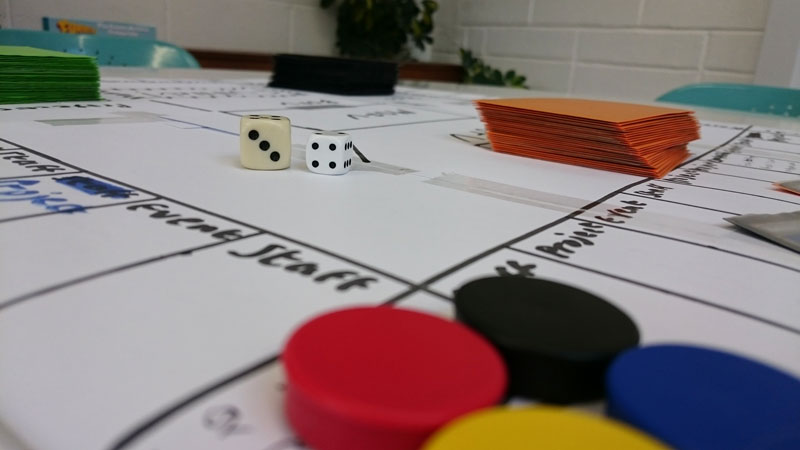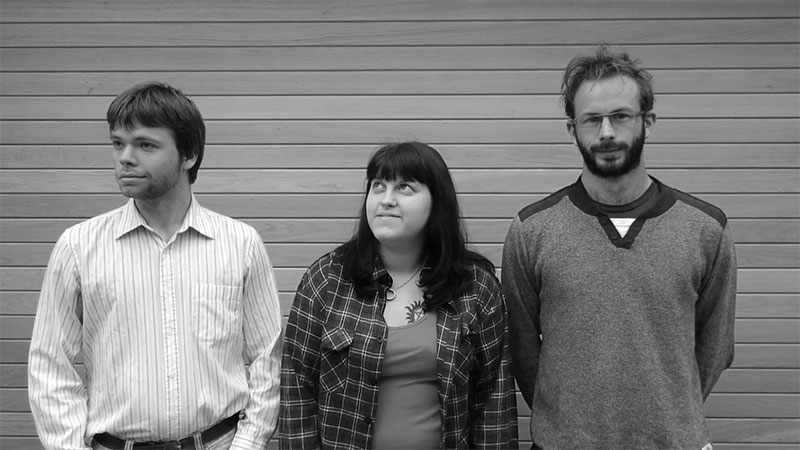If you’re a very, very lucky person, you may have received an interesting package recently. I am of course talking about Funnel! – the content marketing strategy game that’s been landing on literally tens of desks around the world.
For us at Radix, it’s so much more than a board game. It’s the culmination of more than a year’s work, it’s proof that we can turn our hands to creating just about any type of content and make it great, and it’s a living testament to the diverse skills, ideas and personalities that make our team amazing.
It’s also a project that I’m immensely proud to have been a part of. But, as I sit here marvelling at the finished product in my hands, it’s interesting to reflect on how a team of copywriters went from a single passing comment to a highly playable representation of the industry we work in.
We thought it was time we shared the full story of Funnel! with the world. So if you’re sitting comfortably, I’ll begin.
What a long, strange trip it’s been
It’s February 2014. There’s a spirit of opportunity and possibility in the air. A team of energetic and ambitious copywriters convene to chat about Joe Pulizzi’s book, Epic Content Marketing.
After discussing Joe’s thoughts on “breaking through the clutter”, we started thinking about how we could make some noise of our own. “Why don’t we write a book?” a voice suggested. “But Joe says we need to do something different. We need to make a board game!” Kieran replied. Ever the wit, his comment garnered responses ranging from a chuckle to a sharp exhale. But one person wasn’t laughing.
The sound of a lightbulb pinging on drew everyone’s attention to Fiona, who then uttered the two most dangerous words in the history of mankind: “Why not?”
With a raised eyebrow and a wry smile, I turned to George, offering the kind of knowing look that you used to give your best friend when the teacher said you needed to find a partner. He gave me a single nod in return. Game on.
Avengers assemble!
This was happening. We were going to make a board game. We had the idea and the ambition, we just needed a team that was up to the task. Fortunately, at Radix we have a hugely diverse range of skills and backgrounds. For some of us, it was time to dust off talents that we hadn’t put to use for quite some time.
As some of you may or may not know, Radix is also blessed with a disproportionately large geek population. George has genuine game design experience, Emily has designed, created and consumed a huge volume of game-related content, and I spend every moment of my free time analysing, writing about and playing popular card game Magic: The Gathering at a competitive level.
With skills like that at our disposal, the core game design team shaped up quickly. But creating and publishing a board game is a lot more complex than simply making a balanced game that plays well and feels fun. There were a lot more moving parts to consider.
At our first meeting we pinned down all of the roles that needed to be filled, and dished them out accordingly:
- George’s game design experience made him a natural choice for Project Leader
- Emily’s graphic design expertise landed her jobs in both concept art and marketing
- With the intention of leveraging my connections in the UK tabletop gaming community, I volunteered myself for the role of procurement, budget and logistics manager
- We decided freelance artists would be responsible for final art designs
- Because we all had something to contribute to design, the final design team consisted of George, Matt, Kieran, Steve, John, and Emily
- As guardian of the budget, Fiona oversaw us all as Project Sponsor
With the roles locked down, we set ourselves the ambitious final delivery date of March 31st 2015, giving us a full year to complete the project. Various milestones were laid out along the way, but by that date, we wanted the final product in our hands.
Our newly appointed Project Sponsor Fiona set the project budget at £6,000, ensuring we could deliver a professional-looking final product that feels like something you’d find on a store shelf.
Mapping themes to mechanics
With the formalities out of the way, it was time to have some fun. A series of meetings were scheduled to discuss various formats that the game could take, but the first task was pinning down the messages we wanted it to get across – and coming up with creative ways to do it.
After some discussion, a few key themes and ideas emerged:
Theme #1: Good copy/strong content converts prospects
Luckily the industry already has a recognised way of representing the prospect conversion journey – the funnel! It was decided upfront that player progress in the game would be indicated by moving prospect tokens through the funnel somehow.
Theme #2: The importance of choosing the right writer/team for your content
This was suggested to tie in with Fiona’s wildly – well, moderately – successful blog post (now also a hit stage show) the seven types of B2B copywriter. The message here is that choosing the wrong writer for your content can have terrible, terrible consequences.
We started thinking of a way to translate that into the game, and settled on having players assemble a team consisting of writers, designers, marketers, and support staff, each with their own stats, clearly indicating that they are better at some tasks than others.
Theme #3: Representing and responding to key industry trends
As content marketers, we are driven by trends and changes in popular thought. We wanted the gameplay of our board game to be altered by major events in the industry, and by key trends and concepts such as Mark Schaefer’s theory of Content Shock.
We decided that these were best represented in two different ways:
- Named panels around the board for players to land on
- A deck of “event” cards for players to draw at random, each with a unique effect that could impact the progress of everyone, or an individual
On the gameplay side of things, we also had some boxes that we were keen for Funnel! to tick:
- It had to be relatively simple to learn
- It had to be unique enough to stand out
- Players needed subtle ways to interact with each other and derail each other’s strategies
- It had to cast our industry in an amusing light while still conveying some serious messages
- It had to be FUN(nel)! (I’ll see myself out…)
The build phase begins!
With an arsenal of great ideas in hand, our creation was beginning to take shape. The bare bones of the game were laid out, and it was time to go into prototyping.
We spared no expense on research and development, arming George with some marker pens, some thin card stock and the back of an Amazon delivery box. He worked his magic, though, and soon the first iteration of Funnel! came to life.

One of the most important parts of Funnel! is the cards. They represent a player’s team, the projects they want to complete and as previously mentioned, major industry and workplace events. There are a lot of them, and luckily for George’s writing hand, we knew of a handy piece of software that could help us create and print basic prototypes.
With the prototype built, it was time for the moment we’d all been waiting for – our first playtest!
Given that the core testing team was comprised of game designers, reviewers, connoisseurs, and competitive players, we were a tough crowd to satisfy. Our passion for balanced and enjoyable games kept Funnel! in testing for a long time – unfortunately, a little longer than we’d anticipated.
Before long, our timeline was in jeopardy – and it wasn’t just because we wanted to test and refine the game more! As the months got busier in the Radix office, it was becoming harder to fit testing and development time into our diaries (something about writing copy for clients? I don’t really know. Probably best to ask someone in charge).
It soon became clear that to get the game up to the standard we demanded, we were going to need a bit of extra time. Following the lead of some of the greatest game developers of our time, our tentative new deadline became “it’s ready when it’s ready”.
Refined game, unrefined gamers
As testing progressed, many of the core gameplay elements were tweaked and new ideas were constantly flowed into the game. Key concepts and gameplay mechanics were locked down for the cards, and slowly but surely our finished product began to come together.
With the end in sight, we reflected on the game as it stood and what we’d learned from playing it. We were nearly there, but we had some precise changes to make that could have a major impact on gameplay:
- Players were given cards at the start of the game (previously everyone started with nothing) to speed the game along and get to the action faster
- Some abilities were either changed or removed from cards completely because they were either too powerful, too complex, or exploitable to the point that they effectively ended the game on their own
- The number of different cards was cut down significantly due to expected production and illustration costs, but it also helped to streamline the game and make it easier to learn
A new challenger appears
With the game content largely wrapped up, it was time to start making our creation look beautiful. The process of hiring and liaising with an illustrator was new to many of us, but after a short amount of searching we found the perfect partner in local artist, Keith Sparrow.
Keith loved the idea of our game as much as we did, and was happy to fill in some of the artistic blanks that we had overlooked. He got straight to work, and after a couple of meetings and a few tweaks to his illustrations, we had completed board, box, and card art for Funnel! – and it looked amazing.
Seeing Funnel! come to life with the help of Keith’s vibrant and eye-catching art gave us a huge morale boost. It was coming together, our board game dream was becoming a reality, and we really were going to make this happen.
The clock returns, and it’s ticking
2014 turned into 2015, and before we knew it we were already a couple of months in. There was still a lot to do to finish the game off, but fortunately we gained an extra pair of hands in the form of Account Manager Chloe.
With my diary consumed by client work and design input, Chloe picked up the slack on the procurement side of things and quickly found us a production partner in Shannon Games. The company came well reviewed, but production was going to cost a little more than we’d anticipated.
After a chat with our project sponsor, we decided that the best thing to do was to cut our required unit count from 100 to 50. Our exclusive game just got significantly more exclusive.
We agreed to do business with Shannon Games, and not a moment too soon, as Fiona then sprung it on us that she was going to talk at June’s B2B Marketing Summit – and required a finished copy of the game for her presentation!
The final stretch: welcome to the crunch!
Shannon Games sent us through the design templates we needed to flow our art into, and after a few more last minute tweaks to card copy, game rules and mechanics, we were ready for the final stretch.
With the game art and print layouts in hand, it was time for Emily to jump into action. She persevered through the unenviable task of creating card templates and fitting all of the art and copy into them. It was no simple task, but she did an incredible job in a short time.
The cards came out looking as fantastic as everyone imagined, and through diligent and focused design work, a job that threatened to slow us down significantly was completed without a hitch.
This was a huge blessing. Our new deadline that was dismissed by many as being unrealistic and unachievable was all of a sudden looking a lot more possible. Within the space of a few short days, the final template art came in and we were ready to get it all out of the door and onto the printing press.
Now we play the waiting game
With our final designs sent off, we faced a few tough weeks of waiting. Fortunately, this gave us some time to think more deeply about the logistics involved in getting our finished games out to 50 of our favourite people around the world – a welcome distraction from the nail-biting tension over how the games would turn out.
This kept us occupied for a while, and before we knew it, a knock came a-rap-tap-tapping at our door. In rolled an exhausted courier driver pushing a trolley of unmarked boxes. Heads rose from computer monitors around the room and great excitement blended with palpable fear as we opened up the first case of finished games.
But, it didn’t take much inspection before the fear was banished. The games looked fantastic, everyone was delighted, and we got our first opportunity to revel in the majesty of what we’d created. It was almost surreal to see our idea in its finished state, but it was a hugely satisfying feeling and one that I won’ forget for a long time.
We now had a little bit of time to create some useful collateral behind the game in the form of a new microsite. Drawing on the video creation and editing talents of Emily and her partner Paul, and the sharp presentation skills of George “Handsome George” Reith, we put a couple of tutorial clips together to help people get to grips with the game quickly.
While this was going on, each box was thoroughly checked, and a personalised cover letter was added to each one as we prepared to ship them off to their new homes around the world.
After discovering that Sarah and Matt’s buggy built for two unruly children could also comfortably seat 8-10 content marketing strategy games, a low-tech plan was devised for getting them all to the local post office and off out into the big wide world.
Breaking news: people love Funnel!
One of our major ambitions for Funnel! was that people would love receiving it and be eager to share it with others. It wasn’t long after they went out the door that we started seeing a stream of amazing and encouraging social feedback pour in. From tweets and photos of people enjoying playing the game, to blog posts inspired by our idea, the response from our friends and influencers has been nothing short of incredible.
It’s a brilliantly satisfying feeling to see a project of passion be so well received. This was something out of the ordinary for us: we took a risk, we did something we’d never attempted before, and ultimately we used our unique skills and abilities to create something truly different. To see that go down so well within our industry has been one of the most rewarding feelings I’ve had in this job to date.
So where do we go from here?
With the Funnel! project now complete, everyone here is kind of wondering what’s next. We’ve acquired a whole new set of skills outside of what we’d usually do, but when are we going to put them to use again? Or which fringe content format is next on our list to conquer?
Maybe one day we’ll explore the idea of Funnel!’s awkward sequel, but until then, if you want some help creating a board game that’s going to turn some heads and get you noticed, I know the perfect team of highly-skilled geeks for the job. You can find us by calling +44 (0)1326 373592, or emailing the team at funnel@radix-communications.com.


